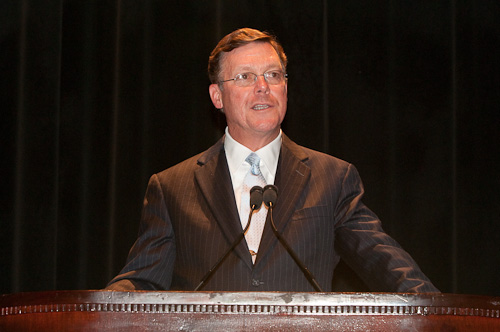Last week, nearly 600 guests gathered at the Waldorf Astoria hotel in Manhattan to celebrate the 30th anniversary of the Spencer Educational Foundation, the leading nonprofit organization dedicated to advancing the education of tomorrow’s risk managers.

Collegial excitement filled the Waldorf as professionals from across the risk management profession united on a night filled with networking, rememberance and celebration of the foundation’s rich history as an organization that has made possible the educational dreams of many aspiring risk managers.
Throughout the evening, a number of presenters took to the stage to draw attention to the foundation’s many ongoing activites. Current Foundation scholars as well as past scholars and foundation president Roger Andrews and chairwoman Donna Galer.

The highlight of the evening, however, was the keynote speech given by gala honoree J. Patrick Gallagher, Jr., chairman, president and CEO of Arthur J. Gallagher & Co. Noting his own company’s long-standing commitment to internships and industry education, Gallagher reiterated not only the importance of supporting education into the risk profession, but the importance of the risk profession itself. To underscore this commitment to excellence, Gallagher announced that his firm would donate $100,000 to fund the creation of the Robert E. Gallagher and John P. Gallagher Scholarship to provide funding for students of risk management disciplines.
“We are grateful for the tremendous generosity of Arthur J. Gallagher & Co., and know that its contribution will be instrumental in cultivating a dynamic next generation of risk and insurance talent,” said Donna Galer, chairwoman of Spencer Educational Foundation, Inc. “This scholarship will be a continuous reminder of the long history of support Arthur J. Gallagher & Co has given Spencer Educational Foundation. We thank Pat Gallagher and his team.”
Since its formation in 1979, the Spencer Educational Foundation has awarded 454 student scholarships totaling $3.6 million and university grants totaling $1.3 million in the United States, Canada and United Kingdom. The Foundation will begin accepting scholarship applications for the 2010-2011 academic year in November 2009.
“My father, John Gallagher, and my uncle, Bob Gallagher, were lifelong proponents of bringing talented young people into the insurance and risk management industries,” said J. Patrick Gallagher, Jr., chairman, president and chief executive officer of Arthur J. Gallagher & Co., who was honored at the gala for his support of the Foundation. “They were committed to giving college students an opportunity to learn about our business, the many career paths it offers and how it impacts society as a whole. Through the Robert E. Gallagher and John P. Gallagher Scholarship program, Arthur J. Gallagher & Co. is helping to ensure that their legacy lives on.
For more photos and coverage of the Spencer gala, be sure to read the RIMS Society page of the November issue of Risk Management.
